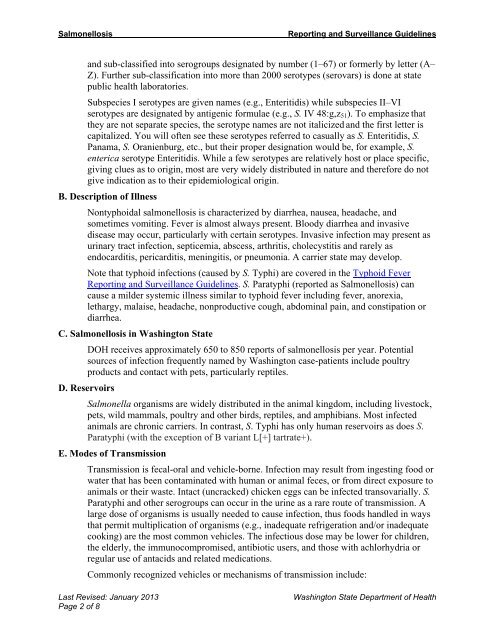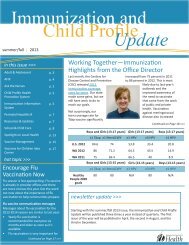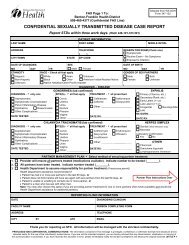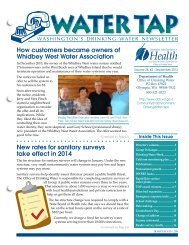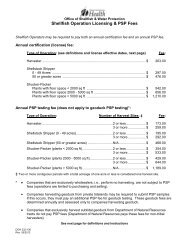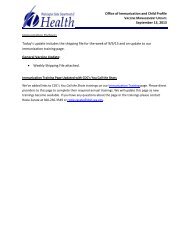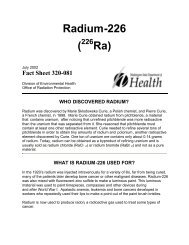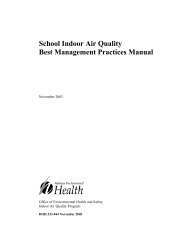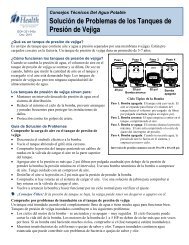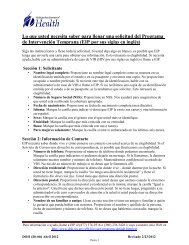Salmonellosis Reporting and Investigation Guideline - Washington ...
Salmonellosis Reporting and Investigation Guideline - Washington ...
Salmonellosis Reporting and Investigation Guideline - Washington ...
Create successful ePaper yourself
Turn your PDF publications into a flip-book with our unique Google optimized e-Paper software.
<strong>Salmonellosis</strong><br />
<strong>Reporting</strong> <strong>and</strong> Surveillance <strong>Guideline</strong>s<br />
<strong>and</strong> sub-classified into serogroups designated by number (1–67) or formerly by letter (A–<br />
Z). Further sub-classification into more than 2000 serotypes (serovars) is done at state<br />
public health laboratories.<br />
Subspecies I serotypes are given names (e.g., Enteritidis) while subspecies II–VI<br />
serotypes are designated by antigenic formulae (e.g., S. IV 48:g,z 51 ). To emphasize that<br />
they are not separate species, the serotype names are not italicized <strong>and</strong> the first letter is<br />
capitalized. You will often see these serotypes referred to casually as S. Enteritidis, S.<br />
Panama, S. Oranienburg, etc., but their proper designation would be, for example, S.<br />
enterica serotype Enteritidis. While a few serotypes are relatively host or place specific,<br />
giving clues as to origin, most are very widely distributed in nature <strong>and</strong> therefore do not<br />
give indication as to their epidemiological origin.<br />
B. Description of Illness<br />
Nontyphoidal salmonellosis is characterized by diarrhea, nausea, headache, <strong>and</strong><br />
sometimes vomiting. Fever is almost always present. Bloody diarrhea <strong>and</strong> invasive<br />
disease may occur, particularly with certain serotypes. Invasive infection may present as<br />
urinary tract infection, septicemia, abscess, arthritis, cholecystitis <strong>and</strong> rarely as<br />
endocarditis, pericarditis, meningitis, or pneumonia. A carrier state may develop.<br />
Note that typhoid infections (caused by S. Typhi) are covered in the Typhoid Fever<br />
<strong>Reporting</strong> <strong>and</strong> Surveillance <strong>Guideline</strong>s. S. Paratyphi (reported as <strong>Salmonellosis</strong>) can<br />
cause a milder systemic illness similar to typhoid fever including fever, anorexia,<br />
lethargy, malaise, headache, nonproductive cough, abdominal pain, <strong>and</strong> constipation or<br />
diarrhea.<br />
C. <strong>Salmonellosis</strong> in <strong>Washington</strong> State<br />
DOH receives approximately 650 to 850 reports of salmonellosis per year. Potential<br />
sources of infection frequently named by <strong>Washington</strong> case-patients include poultry<br />
products <strong>and</strong> contact with pets, particularly reptiles.<br />
D. Reservoirs<br />
Salmonella organisms are widely distributed in the animal kingdom, including livestock,<br />
pets, wild mammals, poultry <strong>and</strong> other birds, reptiles, <strong>and</strong> amphibians. Most infected<br />
animals are chronic carriers. In contrast, S. Typhi has only human reservoirs as does S.<br />
Paratyphi (with the exception of B variant L[+] tartrate+).<br />
E. Modes of Transmission<br />
Transmission is fecal-oral <strong>and</strong> vehicle-borne. Infection may result from ingesting food or<br />
water that has been contaminated with human or animal feces, or from direct exposure to<br />
animals or their waste. Intact (uncracked) chicken eggs can be infected transovarially. S.<br />
Paratyphi <strong>and</strong> other serogroups can occur in the urine as a rare route of transmission. A<br />
large dose of organisms is usually needed to cause infection, thus foods h<strong>and</strong>led in ways<br />
that permit multiplication of organisms (e.g., inadequate refrigeration <strong>and</strong>/or inadequate<br />
cooking) are the most common vehicles. The infectious dose may be lower for children,<br />
the elderly, the immunocompromised, antibiotic users, <strong>and</strong> those with achlorhydria or<br />
regular use of antacids <strong>and</strong> related medications.<br />
Commonly recognized vehicles or mechanisms of transmission include:<br />
Last Revised: January 2013<br />
Page 2 of 8<br />
<strong>Washington</strong> State Department of Health


